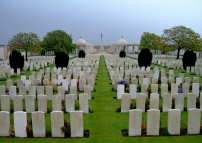| First Name: | Albert Alexander Percy | Last Name: | KEMP | |
|---|---|---|---|---|
| Date of Death: | 13/10/1915 | Lived/Born In: | Millwall | |
| Rank: | Private | Unit: | Norfolk7 | |
| Memorial Site: | 1. Millwall, St Luke 2. Loos Memorial, France | |||
Current Information:Age-20 36 Strafford Street, Millwall The Battle of Loos This battle, fought by the British Army from 25th September, 1915 through to 13th October, was conducted along a six-and-a-half-mile front running north from the mining village of Loos on the outskirts of Lens in Northern France. It was the largest offensive carried out by the British so far in the war. The opening day involved an attack by six divisions, with others entering the fray as it progressed and it was part of a much wider offensive with the French launching their own attacks in Champagne and at Vimy. It was the first time that the British used gas during the war, despite their condemnation of the Germans for doing the same in April 1915. There were some encouraging results on the first day but no major breakthrough was achieved and in the successive days the offensive became mired in trench warfare. By mid-October the battle had petered out with the British having suffered over 60,000 casualties during its course. The last throw of the dice for the British army at Loos came on 13th October, 1915, when there was a renewal of the offensive along much of the line. But this time there were no grand ideas about a breakthrough. The objectives were far more modest and included the recapture of Fosse 8 and the Quarries and the consolidation of the line that ran along the Lens to La Bassée road. The action started at noon with a two hour bombardment of the enemy positions and once again the release of gas. The gas however was ineffective serving only to warn the Germans of the impending attack. When the infantry attack went in at 2pm, two brigades of 12th Division attacked the Quarries in front of Hulluch. 35 Brigade attacked with 7th Norfolk followed by 5th Royal Berkshire on the right and 7th Suffolk followed by 9th Essex on the left. A smoke screen was put down over no-man’s land but it proved to be almost totally inadequate and from their position on the Dump, the enemy was able to observe all that was going on. Not surprisingly 35 Brigade met heavy frontal and enfilade fire when they went over the top. Despite this opposition, 7th Norfolk and 5th Berkshire bombers were able to gain some 300 yards of trench at the south-west corner of the Quarries whilst the bombers of 7th Suffolk in combination with a frontal attack by one company, gained another 250 yards of trench, namely the ‘Hairpin’ on the north-west side of the Quarries. 9th Essex filled the gap between 7th Norfolk and 7th Suffolk. |
||||
| « Back to Search Results | ||||
| If you think any of the information shown here is incorrect, Click Here to submit your amends and comments | ||||




